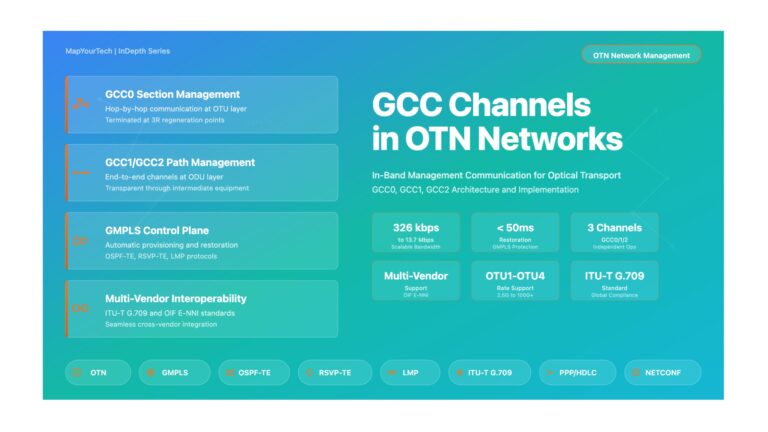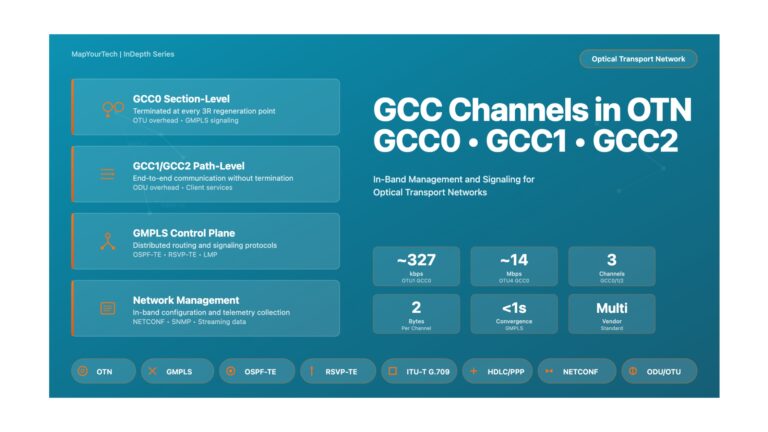Introduction
Automatic Protection Switching (APS) is one of the most valuable features of SONET and SDH networks. Networks with APS quickly react to failures, minimizing lost traffic, which minimizes lost revenue to service providers. The network is said to be “self healing.” This application note covers how to use Sunrise Telecom SONET and SDH analyzers to measure the amount of time it takes for a network to complete an automatic protection switchover. This is important since ANSI T1.105.1 and ITU-T G.841 require that a protection switchover occur within 50 ms. To understand the APS measurement, a brief review is first given. This is followed by an explanation of the basis behind the APS measurement. The final section covers how to operate your Sunrise Telecom SONET and SDH equipment to make an APS time measurement.
What Is APS?
Automatic Protection Switching keeps the network working even if a network element or link fails. The Network Elements (NEs) in a SONET/SDH network constantly monitor the health of the network. When a failure is detected by one or more network elements, the network proceeds through a coordinated predefined sequence of steps to transfer (or switchover) live traffic to the backup facility (also called “protection” facility). This is done very quickly to minimize lost traffic. Traffic remains on the protection facility until the primary facility (working facility) fault is cleared, at which time the traffic may revert to the working facility.
In a SONET or SDH network, the transmission is protected on optical sections from the Headend (the point at which
the Line/Multiplexer Section Overhead is inserted) to the Tailend (the point where the Line/Multiplexer Section Overhead is terminated).
The K1 and K2 Line/Multiplexer Section Overhead bytes carry an Automatic Protection Switching protocol used to coordinate protection switching between the headend and the tailend.
The protocol for the APS channel is summarized in Figure 1. The 16 bits within the APS channel contain information on the APS configuration, detection of network failure, APS commands, and revert commands. When a network failure is detected, the Line/Multiplexer Section Terminating Equipment communicates and coordinates the protection switchover by changing certain bits within the K1 & K2 bytes.

During the protection switchover, the network elements signal an APS by sending AIS throughout the network. AIS is also present at the ADM drop points. The AIS condition may come and go as the network elements progress through their algorithm to switch traffic to the protection circuit.
AIS signals an APS event. But what causes the network to initiate an automatic protection switchover? The three most common are:
- • Detection of AIS (AIS is used to both initiate and signal an APS event)
- • Detection of excessive B2 errors
- • Initiation through a network management terminal
According to GR-253 and G.841, a network element is required to detect AIS and initiate an APS within 10 ms. B2 errors should be detected according to a defined algorithm, and more than 10 ms is allowed. This means that the entire time for both failure detection and traffic restoration may be 60 ms or more (10 ms or more detect time plus 50 ms switch time).
Protection Architectures
There are two types of protection for networks with APS:
- Linear Protection, based on ANSI T1.105.1 and ITU-T G.783 for point-to-point (end-to-end) connections.
- Ring Protection, based on ANSI T1.105.1 and ITU-T G.841 for ring structures (ring structures can also be found with two
types of protection mechanisms – Unidirectional and Bidirectional rings).
Refer to Figures 2-4 for APS architectures and unidirectional vs. bidirectional rings.

Protection Switching Schemes
The two most common schemes are 1+1 protection switching and 1:n protection switching. In both structures, the K1 byte contains both the switching preemption priorities (in bits 1 to 4), and the channel number of the channel requesting action (in bits 5 to 8). The K2 byte contains the channel number of the channel that is bridged onto protection (in bits 1 to 4), and the mode type (in bit 5); bits 6 to 8 contain various conditions such as AIS-L, RDI-L, indication of unidirectional or bidirectional switching.

1+1
In 1+1 protection switching, there is a protection facility (backup line) for each working facility. At the headend, the optical signal is bridged permanently (split into two signals) and sent over both the working and the protection facilities simultaneously, producing a working signal and a protection signal that are identical. At the tailend, both signals are monitored independently for failures. The receiving equipment selects either the working or the protection signal. This selection is based on the switch initiation criteria which are either a signal fail (hard failure such as the loss of frame (LOF) within an optical signal), or a signal degrade (soft failure caused by a bit error ratio exceeding some predefined value).
Refer to Figure 5.

Normally, 1+1 protection switching is unidirectional, although if the line terminating equipment at both ends supports bidirectional switching, the unidirectional default can be overridden. Switching can be either revertive (the flow reverts to the working facility as soon as the failure has been corrected) or nonrevertive (the protection facility is treated as the working facility)
In 1+1 protection architecture, all communications from the headend to the tailend are carried out over the APS channel via the K1 and K2 bytes. In 1+1 bidirectional switching, the K2 byte signaling indicates to the headend that a facility has been switched so that it can start to receive on the now active facility.
1:n
In 1:n protection switching, there is one protection facility for several working facilities (the range is from 1 to 14) and all communications from the headend to the tailend are carried out over the APS channel via the K1 and K2 bytes. All switching is revertive, that is, the traffic reverts back to the working facility as soon as the failure has been corrected. Refer to Figure 6.

Optical signals are normally sent only over the working facilities, with the protection facility being kept free until a working facility fails. Let us look at a failure in a bidirectional architecture. Suppose the tailend detects a failure on working facility 2. The tailend sends a message in bits 5-8 of the K1 byte to the headend over the protection facility requesting switch action. The headend can then act directly, or if there is more than one problem, the headend decides which is top priority. On a decision to act on the problem on working facility 2, the headend carries out the following steps:
- Bridges working facility 2 at the headend to the protection facility.
- Returns a message on the K2 byte indicating the channel number of the traffic on the protection channel to the tailend
- Sends a Reverse Request to the tailend via the K1 byte to initiate bidirectional switch.
On receipt of this message, the tailend carries out the following steps:
-
- Switches to the protection facility to receive
- Bridges working facility 2 to the protection facility to transmit back
Now transmission is carried out over the new working facility.
Switch Action Comments
In unidirectional architecture, the tailend makes the decision on priorities. In bidirectional architecture, the headend makes the decision on priorities. If there is more than one failure at a time, a priority hierarchy determines which working facility will be backed up by the protection facility. The priorities that are indicated in bits 1-4 of the K1 byte are as follows:
- Lockout
- Forced switch (to protection channel regardless of its state) for span or ring; applies only to 1:n switching
- Signal fails (high then low priority) for span or ring
- Signal degrades (high then low priority) for span or ring; applies only to 1:n switching
- Manual switch (to an unoccupied fault-free protection channel) for span or ring; applies only to 1+1 LTE
- Wait-to-restore
- Exerciser for span or ring (may not apply to some linear APS systems)
- Reverse request (only for bidirectional)
- Do not revert (only 1+1 LTE provisioned for nonrevertive switching transmits Do Not Revert)
- No request
Depending on the protection architecture, K1 and K2 bytes can be decoded as shown in Tables 1-5.
Linear Protection (ITU-T G.783)

Ring Protection (ITU-T G.841)

collected from Sunrise Telecom APS application note..
Unlock Premium Content
Join over 400K+ optical network professionals worldwide. Access premium courses, advanced engineering tools, and exclusive industry insights.
Already have an account? Log in here




